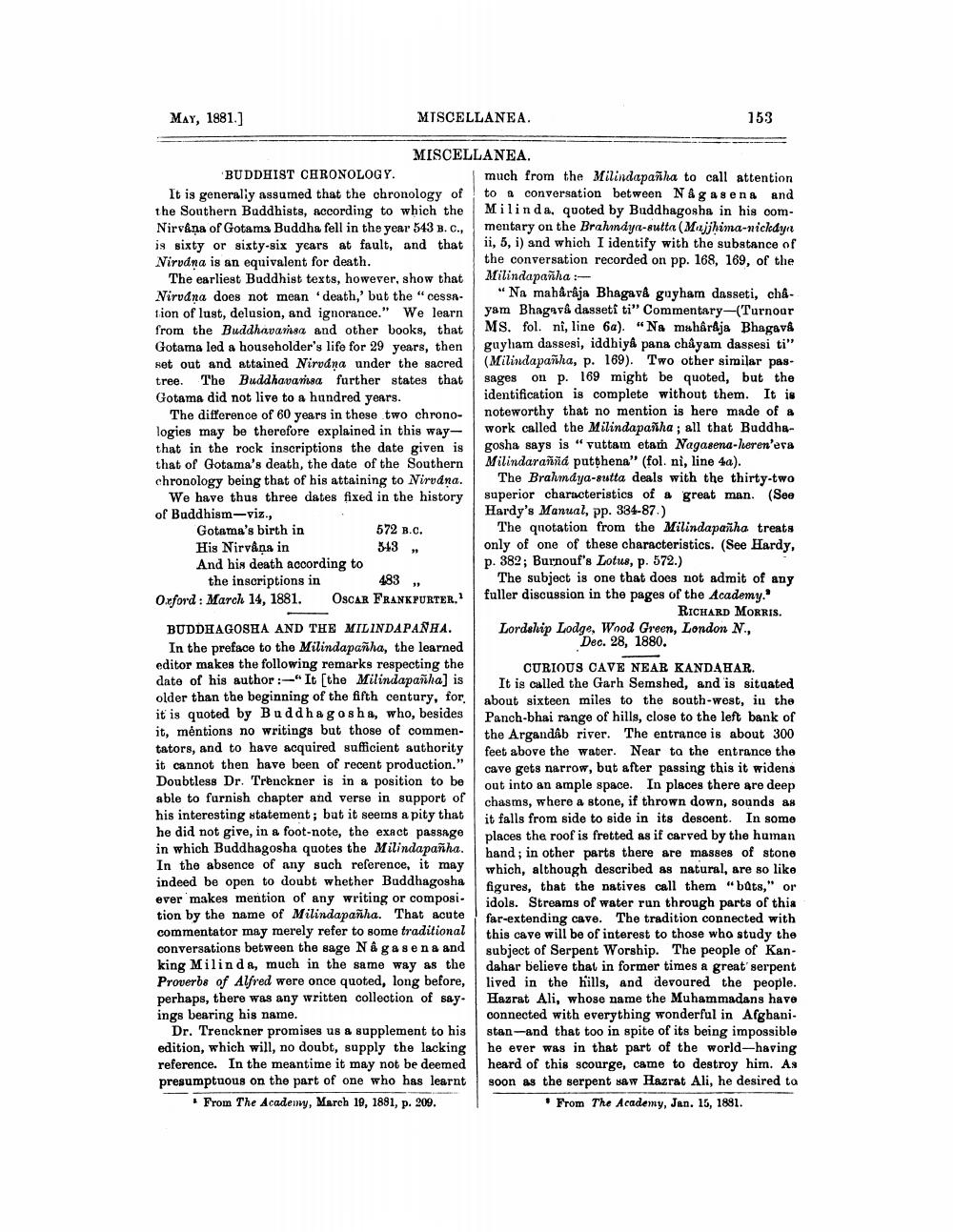________________
MAY, 1881.]
MISCELLANEA
153
572 B.C.
MISCELLANEA. BUDDHIST CHRONOLOGY.
much from the Milindapañha to call attention It is generally assumed that the chronology of to a conversation between Någasena and the Southern Buddhists, according to which the Milinda, quoted by Buddhagosha in his oomNirvana of Gotama Buddha fell in the year 543 B. C., mentary on the Brahmdya-sutta (Majjhima-nickedyn is sixty or sixty-six years at fault, and that
ii, 5, i) and which I identify with the substance of Nirvdna is an equivalent for death.
the conversation recorded on pp. 168, 169, of the The earliest Buddhist texts, however, show that
Milindapañha :Nirudna does not mean death,' but the "cessa
"No maharaja Bhagavå guyham dasseti, ch&tion of lust, delusion, and ignorance." We learn yam Bhagav& dassets ti" Commentary-(Turnoar from the Buddhavamsa and other books, that
MS. fol. ni, line 6a). “Na maharaja Bhagava Gotama led a householder's life for 29 years, then guyham dassesi, iddhiya pana chảyam dassesi ti" Het out and attained Nirvana under the sacred (Milindapanha, p. 169). Two other similar pastree. The Buddhavansa further states that sages on p. 169 might be quoted, but the Gotama did not live to a hundred years.
identification is complete without them. It is The difference of 60 years in these two chrono
noteworthy that no mention is here made of a logies may be therefore explained in this way
work called the Milindapanha; all that Buddhathat in the rock inscriptions the date given is gosha says is "vuttam etam Nagasena-leren'era that of Gotama's death, the date of the Southern Milindarañá putthena" (fol. ni, line 4a). chronology being that of his attaining to Nirvana.
The Brahmdya-sutta deals with the thirty-two We have thus three dates fixed in the history superior characteristics of a great man. (See of Buddhism-viz.,
Hardy's Manual, pp. 334-87.) Gotama's birth in
The qnotation from the Milindapañha treats His Nirvana in
343 , only of one of these characteristics. (See Hardy, And his death according to
p. 382; Burnouf's Lotus, p. 572.) the inscriptions in 483,
The subject is one that does not admit of any Orford: March 14, 1881. OSCAR FRANKPURTER, fuller discussion in the pages of the Academy."
RICHARD MORRIS. BUDDHAGOSHA AND THE MILINDAPANHA. Lordship Lodge, Wood Green, London N., In the preface to the Milindapañha, the learned
Dec. 28, 1880. editor makes the following remarks respecting the CURIOUS CAVE NEAR KANDAHAR. date of his author :- It (the Milindapanha) is It is called the Garh Semshed, and is situated older than the beginning of the fifth century, for about sixteen miles to the south-west, in the it is quoted by Buddha gosha, who, besides
Panch-bhai range of hills, close to the left bank of it, mentions no writings but those of commen- the Argandab river. The entrance is about 300 tators, and to have acquired sufficient authority
feet above the water. Near to the entrance the it cannot then have been of recent production."
cave gets narrow, but after passing this it widens Doubtless Dr. Trenckner is in a position to be out into an ample space. In places there are deep able to furnish chapter and verse in support of
chasms, where a stone, if thrown down, sounds as his interesting statement; but it seems a pity that it falls from side to side in its descent. In some he did not give, in a foot-note, the exact passage
places the roof is fretted as if carved by the human in which Buddhagosha quotes the Milindapañha.
hand; in other parts there are masses of stone In the absence of any such reference, it may
which, although described as natural, are so like indeed be open to doubt whether Buddhagosha
figures, that the natives call them "bats," or ever makes mention of any writing or composi.
idols. Streams of water run through parts of this tion by the name of Milindapañha. That acute
far-extending cave. The tradition connected with commentator may merely refer to some traditional
this cave will be of interest to those who study the conversations between the sage Nå gasena and subject of Serpent Worship. The people of Kanking Milinda, much in the same way as the dahar believe that in former times a great serpent Proverbs of Alfred were once quoted, long before, lived in the hills, and devoured the people. perhaps, there was any written collection of say. Hazrat Ali, whose name the Muhammadans have inge bearing his name.
connected with everything wonderful in Afghani. Dr. Trenckner promises us a supplement to his stan-and that too in spite of its being impossible edition, which will, no doubt, supply the lacking he ever was in that part of the world-having reference. In the meantime it may not be deemed heard of this scourge, came to destroy him. As presumptuous on the part of one who has learnt soon as the serpent saw Hazrat Ali, he desired to From The Academy, March 19, 1891, p. 209.
. From The Academy, Jan. 15, 1881.




